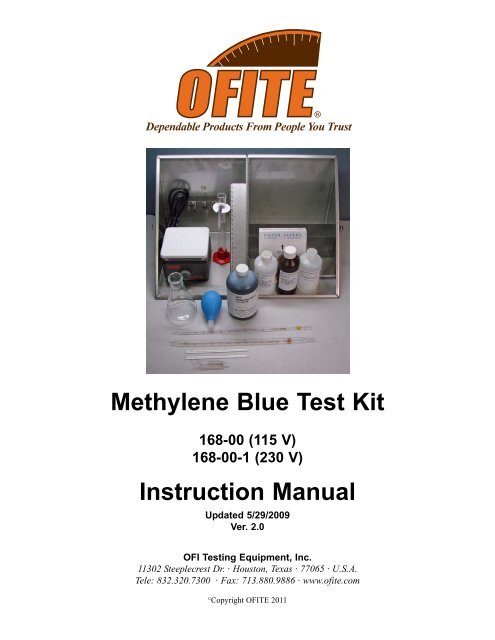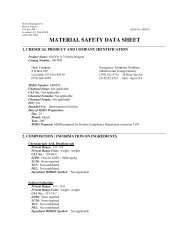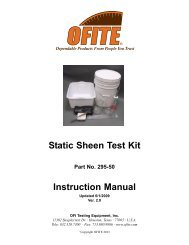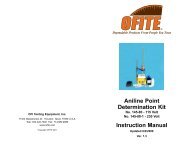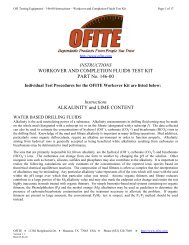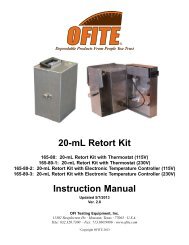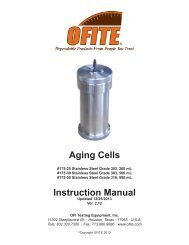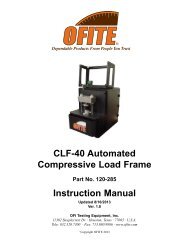Methylene Blue Test Kit - OFI Testing Equipment, Inc.
Methylene Blue Test Kit - OFI Testing Equipment, Inc.
Methylene Blue Test Kit - OFI Testing Equipment, Inc.
You also want an ePaper? Increase the reach of your titles
YUMPU automatically turns print PDFs into web optimized ePapers that Google loves.
<strong>Methylene</strong> <strong>Blue</strong> <strong>Test</strong> <strong>Kit</strong><br />
168-00 (115 V)<br />
168-00-1 (230 V)<br />
Instruction Manual<br />
Updated 5/29/2009<br />
Ver. 2.0<br />
<strong>OFI</strong> <strong>Test</strong>ing <strong>Equipment</strong>, <strong>Inc</strong>.<br />
11302 Steeplecrest Dr. · Houston, Texas · 77065 · U.S.A.<br />
Tele: 832.320.7300 · Fax: 713.880.9886 · www.ofite.com<br />
©<br />
Copyright <strong>OFI</strong>TE 2011
Table of<br />
Contents<br />
Intro.......................................................................................................2<br />
Components.........................................................................................2<br />
Safety ....................................................................................................3<br />
Procedure.............................................................................................4<br />
Calculation ...........................................................................................5<br />
Maintenance.........................................................................................6<br />
Appendix ..............................................................................................7<br />
<strong>OFI</strong>TE, 11302 Steeplecrest Dr., Houston, TX 77065 USA / Tel: 832-320-7300 / Fax: 713-880-9886 / www.ofite.com 1
Intro<br />
The methylene blue capacity of a drilling fluid is an indication of the amount<br />
of reactive clays (bentonite or drilled solids) present as determined by the<br />
methylene blue test (MBT). The methylene blue capacity gives an estimate<br />
of the total cation exchange capacity (CEC) of the solids in the drilling fluid.<br />
The methylene blue capacity and the cation exchange capacity are not<br />
necessarily equivalent, with the methylene blue capacity normally being<br />
somewhat less than the actual cation exchange capacity. <strong>Methylene</strong> blue<br />
solution is added to a sample of drilling fluid which has been treated with<br />
hydrogen peroxide and acidified until saturation is noted by the formation of<br />
a “dye halo” around a drop of solids placed on filter paper. Drilling fluids<br />
frequently contain substances in addition to reactive clays that also absorb<br />
methylene blue dye. Pretreatment with hydrogen peroxide removes these<br />
effects from organic materials such as lignosulfonates, lignites, cellulosic<br />
polymers and polyacrylates, etc.<br />
Components<br />
#134-36-1 Red Knob for Bleeder Valve<br />
#140-56 12.5 cm Filter Paper; Whatman Grade 1; Package of 100<br />
#144-36 Multi-Purpose <strong>Kit</strong>; Diagonal; Large<br />
#153-14 Glass Graduated Cylinder; 50 mL × 1 mL<br />
#153-29 Glass-Tip Syringe; 2cc<br />
#153-34 Glass Pipet; 1 mL × 1/100 mL<br />
#153-40 Glass Pipet; 10 mL × 1/10 mL<br />
#153-41 Pipet Aid; Safety Bulb<br />
#153-50 250 mL Erlenmeyer Flask<br />
#163-27 Medium Clip<br />
#163-28 Large CLip; Qty: 2<br />
#168-03 Hot Plate; 120V -OR-<br />
#168-03-1 Hot Plate; 230V<br />
#168-04 6" Glass Stirring Rod; Qty: 2<br />
#200-03 <strong>Methylene</strong> <strong>Blue</strong> Solution; 1 mL - 0.01 ME; 16 oz.; 500 mL<br />
#200-11 Hydrogen Peroxide; 3%; 8 oz.; 250 mL<br />
#206-01 Deionized Water; 8 oz.; 250 mL<br />
#230-13 *Sulfuric Acid; 5N; 8 oz.; 250 mL; UN #2796<br />
<strong>OFI</strong>TE, 11302 Steeplecrest Dr., Houston, TX 77065 USA / Tel: 832-320-7300 / Fax: 713-880-9886 / www.ofite.com 2
Safety<br />
Hot Plate<br />
1. Make sure the hot plate is rated for the proper voltage before plugging<br />
it in.<br />
2. Make sure the electrical cord is in good condition and equipped with a<br />
grounding plug.<br />
3. Do not leave the hot plate unattended while heating.<br />
4. Use caution while handling hot flasks and other laboratory containers.<br />
Chemicals<br />
The chemicals used in this kit (methylene blue solution, hydrogen peroxide<br />
3%, and sulfuric acid 5N), are hazardous to your health. Avoid direct contact,<br />
inhalation, and ingestion. Keep away from fire and other heat<br />
sources.<br />
Read all warnings, precautions, and hazard classifications (flammability,<br />
health, and reactivity) on the container label.<br />
For in depth information on handling, reactivity with other substances, storage,<br />
and other safety related information, refer to the “Material Safety Data<br />
Sheet” (MSDS) for each chemical. If personal contact or an environmental<br />
accident occur, use the counteractive measures outlines on the MSDS.<br />
As preventive measures:<br />
1. Never pipette any chemical by mouth. Always use a pipette aid<br />
(#153-42 or equivalent) to load chemicals into a pipette.<br />
2. Avoid contact with skin. Wear impervious, protective clothing,<br />
including boots, apron, gloves, lab coat or coveralls, as appropriate,<br />
to prevent skin contact.<br />
3. Do not inhale vapors or take internally.<br />
4. Use chemical safety goggles and/or full face shield where splashing<br />
is possible. Maintain an eye wash fountain and quick drench facilities<br />
in the work area.<br />
<strong>OFI</strong>TE, 11302 Steeplecrest Dr., Houston, TX 77065 USA / Tel: 832-320-7300 / Fax: 713-880-9886 / www.ofite.com 3
Procedure<br />
Note<br />
1. With the syringe, add 2.0 mL of drilling fluid to the erlenmeyer flask. Air<br />
or gas entrained in the drilling fluid must be removed prior to injection.<br />
Vigorously stir the drilling fluid to break the gel and quickly draw the<br />
mud into the syringe. Then slowly discharge the syringe back into the<br />
drilling fluid keeping the tip submerged. Again draw the fluid into the<br />
syringe and deliver exactly 2.0 mL of fluid to the flask.<br />
If less than 2.0 mL or more than 10.0 mL of methylene blue solution will<br />
be required, the volume of drilling fluid sample may be increased or<br />
decreased to a more convenient size.<br />
2. Add 10 mL of deionized water to the erlenmeyer flask.<br />
3. Add 15 mL of 3% hydrogen peroxide to the flask.<br />
4. Add 0.5 mL of 5N sulfuric acid to the mixture.<br />
5. Using the hot plate, boil gently for 10 minutes. Do not allow to boil to<br />
dryness.<br />
6. Dilute the mixture to about 50 mL using deionized water.<br />
<br />
Tip<br />
7. Add methylene blue solution to the flask in increments of 0.5 mL. After<br />
each addition of methylene blue solution swirl the contents of the flask<br />
for about 30 seconds.<br />
If the approximate amount of methylene blue dye is known from previous<br />
testing, then larger increments may be used at the beginning of the<br />
procedure.<br />
8. While the solids are still suspended, remove one drop of liquid with the<br />
stirring rod and place the drop on the filter paper. The initial end point<br />
of the titration is reached when the dye appears as a blue turquoise<br />
ring surrounding the dyed solids.<br />
9. When the blue tint halo spreading from the spot is detected, shake the<br />
flask an additional 2 minutes and place another drop on the filter paper.<br />
If the blue ring is again evident, the final endpoint has been reached. If<br />
the blue ring does not appear, then continue as before until a drop<br />
taken after 2 minutes shows the blue tint halo.<br />
<strong>OFI</strong>TE, 11302 Steeplecrest Dr., Houston, TX 77065 USA / Tel: 832-320-7300 / Fax: 713-880-9886 / www.ofite.com 4
Calculation<br />
<strong>Methylene</strong> <strong>Blue</strong> Capacity =<br />
<strong>Methylene</strong> <strong>Blue</strong> (mL)<br />
Drilling Fluid (mL)<br />
The methylene blue capacity may also be reported as pounds per barrel of<br />
equivalent bentonite, based on bentonite with a cation exchange capacity<br />
of 70 meq / 100 grams.<br />
Bentonite equivalent (lb/bbl) =<br />
5 (<strong>Methylene</strong> <strong>Blue</strong> mL)<br />
Drilling Fluid (mL)<br />
Bentonite equivalent (kg/m 3 ) = 2.85 × Bentonite equivalent (lb/bbl)<br />
<strong>OFI</strong>TE, 11302 Steeplecrest Dr., Houston, TX 77065 USA / Tel: 832-320-7300 / Fax: 713-880-9886 / www.ofite.com 5
Maintenance<br />
<strong>Methylene</strong> <strong>Blue</strong> is a dye, and if allowed to dry on glassware or other laboratory<br />
equipment, will cause a stain that is difficult or impossible to remove.<br />
1. Avoid spilling methylene blue.<br />
2. Thoroughly wash and dry all laboratory equipment and glassware<br />
immediately after use.<br />
3. Make sure methylene blue bottles are closed tightly after use.<br />
<strong>OFI</strong>TE, 11302 Steeplecrest Dr., Houston, TX 77065 USA / Tel: 832-320-7300 / Fax: 713-880-9886 / www.ofite.com 6
Appendix<br />
Spot <strong>Test</strong>s for End Point of <strong>Methylene</strong> <strong>Blue</strong> Titration<br />
*Free dye detected immediately after adding the 6 th mL is adsorbed after 2<br />
minutes and indicates that the end point has not quite been reached.<br />
<strong>OFI</strong>TE, 11302 Steeplecrest Dr., Houston, TX 77065 USA / Tel: 832-320-7300 / Fax: 713-880-9886 / www.ofite.com 7


